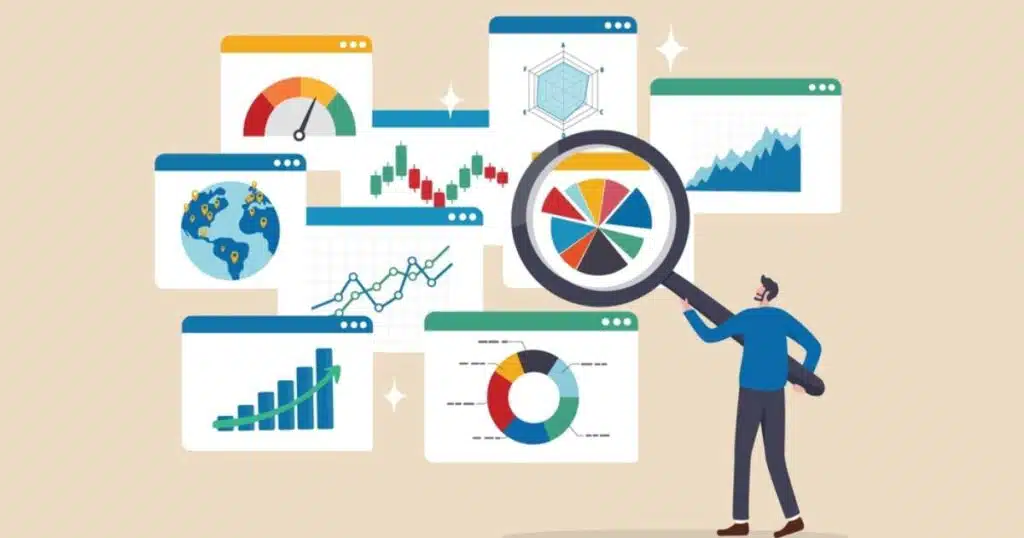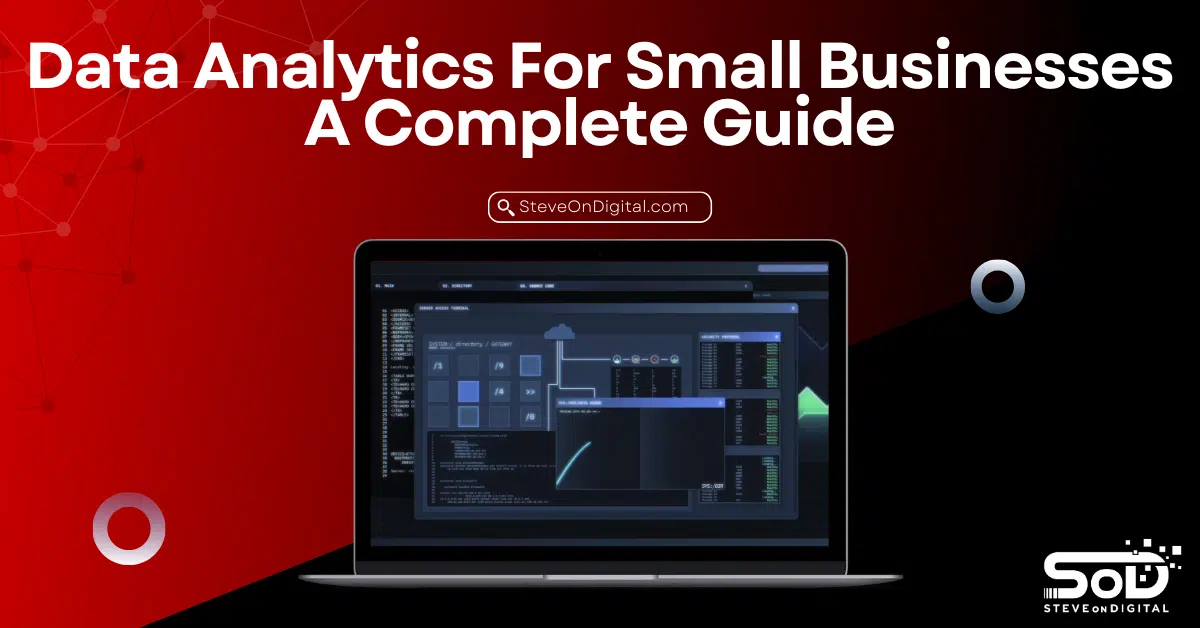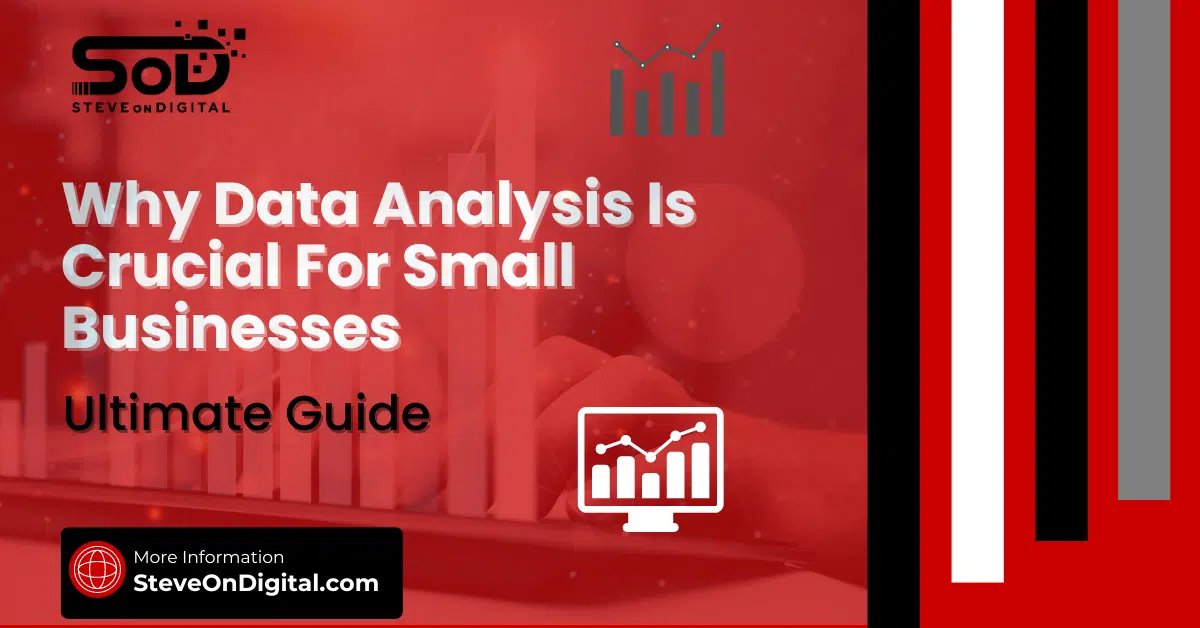In the ever-evolving business landscape, the power of data analytics cannot be overstated, especially for small businesses.
Understanding and leveraging data analytics is crucial for gaining a competitive edge and fostering substantial business growth.
As someone who has navigated through various facets of digital transformation and seen its impact firsthand, I, Steve Johnston, firmly believe in the transformative power of data analytics for small enterprises.
Let’s delve into how this tool can be a game changer for your business.
Data Analytics
In simple terms, data analytics involves examining raw data to draw conclusions and make informed decisions.
For small businesses, utilizing data analytics can lead to actionable insights that drive smarter, data-driven decisions.
These decisions often lead to optimizing business operations and enhancing customer satisfaction, thereby offering a distinct competitive advantage.
From my experience, integrating data analytics tools into your business processes can transform mundane data into a gold mine of insights.
For instance, predictive business analytics accessible through platforms like Google Analytics can forecast market trends and customer behaviors, giving small businesses a leg up in strategic planning.
Driving Business Growth Through Insightful Data Analysis
The use of data analytics extends beyond simple analysis; it fosters an environment where continuous improvement is possible and encouraged.
I’ve seen many small business data analytics initiatives where insights garnered from sales data or customer interactions led to refined marketing strategies and improved product offerings.
Imagine knowing precisely what your customers prefer or the exact time they are most likely to make a purchase—this is the power of data analysis at work.
By leveraging tools and techniques of data analysis, small businesses can not only survive but thrive by adapting quickly to market changes and customer needs.
Exploring The Types Of Data Available To Small Businesses
Understanding the types of data you have at your disposal is the first step towards harnessing the power of analytics.
Let’s break down the data types most relevant to small businesses and discuss how these can be utilized effectively.
Structured vs. Unstructured vs. Historical Data
Data can generally be categorized into three types: structured, unstructured, and historical.
Structured data is organized and easily searchable (like data in spreadsheets), which makes it ideal for traditional data analysis techniques.
Unstructured data, which includes emails, videos, and social media traffic, is less organized and requires more advanced techniques like data mining to uncover patterns and insights.
Lastly, historical data refers to data collected over time that can reveal trends and help predict future occurrences when used with predictive analytics.
In my role as a Digital Transformation Specialist, I have helped numerous small businesses implement systems that efficiently collect and analyze these types of data.
Real Examples Of Data Sources
One of the most common sources of structured data for small businesses is Customer Relationship Management (CRM) systems.
These systems not only store customer information but also track interactions, sales, and marketing efforts, providing a rich source of actionable data.
For example, analyzing CRM data can help in improving customer retention strategies by identifying key touchpoints that lead to enhanced customer experiences.
Sales analytics, another critical data source, involves examining sales reports and performance metrics to evaluate overall sales performance and adjust tactics accordingly.
Marketing communications data, such as email open rates or social media engagement metrics, can also provide valuable insights into customer preferences and behavior.
These insights can then be used to tailor marketing efforts for maximum impact.
Key Data Analytics Techniques For Enhancing Small Business Operations
Navigating the world of data analytics can be overwhelming for small business owners, but understanding its core techniques is crucial for harnessing its full potential.
Here, we’ll explore four primary types of data analysis techniques: descriptive, diagnostic, predictive, and prescriptive.
Each offers unique benefits and insights that can drastically enhance business operations.
Descriptive Analytics: Understanding The Present
The first step in data analytics involves descriptive analytics.
This technique summarizes raw data and converts it into a form that is easily understandable, helping to identify patterns and trends.
For example, small businesses can use descriptive analytics through tools like Google Analytics to see social media traffic and website visitors.
This helps in understanding customer behavior, providing a clear picture of what is currently happening in the business.
Diagnostic Analytics: Why Things Happen
Next, diagnostic analytics digs deeper—it looks at the data collected and analyzes it to determine causes and effects.
For instance, if a small business notices a drop in sales, diagnostic analytics can help pinpoint exactly when and why this decline began by analyzing historical sales data and marketing efforts.
This is invaluable for adjusting strategies to better align with market trends and customer preferences.
Predictive Analytics: Forecasting The Future
Moving forward, predictive analytics uses statistical analysis and machine learning techniques to forecast future outcomes based on historical data.
For small businesses, applying predictive analytics can mean predicting customer retention successes based on past customer behavior patterns and engagement levels.
Tools such as predictive business analytics accessible in advanced business software provide these insights, which are crucial for strategic planning and making informed decisions.
Prescriptive Analytics: Advising On Possible Outcomes
Finally, prescriptive analytics goes one step further by not only predicting the future but also suggesting actions to benefit from the predictions.
This is achieved through a combination of business rules, algorithms, machine learning, and computational modeling.
For example, if predictive analytics suggests an upcoming increase in demand for certain products, prescriptive analytics would recommend increasing inventory levels or adjusting pricing models to maximize profits.
Practical Applications
The practical application of these analytics techniques in a small business setting can lead to significant improvements in efficiency and profitability.
By leveraging data analytics, small businesses can gain valuable insights into customer acquisition, enhance marketing campaigns, and optimize business operations.
From my experience, implementing these techniques has led to more targeted marketing campaigns and improved customer experiences, directly impacting business growth positively.
Tools And Technologies
For small businesses venturing into data analytics, choosing the right tools is critical.
There’s a plethora of data analytics tools available, but selecting the right one depends on several factors such as budget, business size, and specific needs.
Introduction To Essential Data Analytics Tools For Small Businesses
Starting with Google Analytics, this tool is fundamental for small businesses to analyze website traffic, understand customer behavior, and improve online marketing strategies.

Furthermore, business intelligence software like Tableau or Microsoft Power BI provides deeper insights with data visualization tools that help present data in a more comprehensible way, making it easier to make strategic decisions.
Criteria For Selecting The Right Tools
When selecting data analytics tools, small businesses should consider:
- Budget: It’s crucial to choose tools that offer essential features without breaking the bank.
- Scalability: The tool should be able to grow with your business, handling increased data and more complex needs over time.
- Specific Business Needs: Different businesses have different needs; for example, a retail business might benefit more from inventory management analytics, while a service-oriented business might focus on customer relationship management data.
| Data Analytics Tool | Key Features | Cost Range | Ideal for Business Size |
| Google Analytics | Traffic analysis, real-time data, customer segmentation | Free to $150/month | Small to Medium |
| Tableau | Advanced visualizations, interactive dashboards | $70/user/month | Medium to Large |
| Microsoft Power BI | Data sharing, large dataset analysis, integration with MS products | $9.99/user/month | Small to Large |
| Zoho Analytics | Drag-and-drop interface, deep analytical capabilities | $25/month | Small to Medium |
Choosing the right tools and technologies is not just about managing data but also about transforming this data into actionable insights that drive decisions.
Data Collection Strategies For Small Businesses
Effective data collection is the foundation of successful data analytics for small businesses.
Gathering the right data efficiently and accurately can transform how a business operates, providing critical insights that drive growth and improvement.
Here, I’ll share some of the best practices in data collection that I’ve utilized effectively within my own digital strategy business, along with strategies to harness various data sources.
Best Practices In Data Collection To Ensure The Acquisition Of High-Quality, New Data
Ensuring the collection of high-quality data is paramount for any analysis to be meaningful.
- Establish Clear Data Collection Goals: Before gathering data, it’s crucial to know what you’re looking to achieve with the data. This helps in collecting data that is relevant and actionable.
- Use the Right Tools: Employing robust data collection tools such as customer relationship management (CRM) systems or Google Analytics can help capture accurate and comprehensive data.
- Ensure Data Accuracy: Regular checks and balances should be in place to verify and validate the data collected. This prevents the analysis of misleading information which can lead to faulty conclusions.
Utilizing Various Data Sources
Small businesses must maximize the use of all available data sources to paint a full picture of their business landscape.
- Internal Systems: These include CRM, inventory management systems, and sales analytics software. Such systems provide structured data that is crucial for analyzing business operations and customer behavior.
- Publicly Available Data: This includes market trends, industry reports, and demographic information from government databases. Leveraging this type of data can help small businesses understand external factors affecting their market.
- Customer Feedback: Direct feedback from customers through surveys, social media, and direct communications provides invaluable data on customer preferences and satisfaction. This unstructured data can be challenging to analyze but offers deep insights into improving products and services.
Implementing Big Data Analytics In Small Business Settings
Implementing big data analytics in a small business might seem daunting due to perceived high costs and technical complexity.
However, with the right approach, even small enterprises can leverage the power of big data to enhance their business operations.
Here’s a straightforward guide on setting this up and addressing common challenges.
Step-by-Step Guide On Setting Up A Big Data Analysis System
- Identify What Data is Needed: Start by determining what kind of data will be most beneficial for your business. This could include customer data, sales performance, or marketing ROI.
- Choose Appropriate Big Data Tools: Depending on your specific needs, tools like Hadoop or cloud-based analytics services from providers like Google or Amazon can be incredibly effective. These platforms can manage large volumes of data and provide powerful computing capabilities.
- Implement Data Collection Methods: Set up automated data collection through your business software systems. This ensures a steady stream of fresh data for analysis.
- Analyze and Interpret Data: Use data analytics tools to process and analyze the data. These tools often come with data visualization capabilities to help present data findings in an easily understandable format.
Challenges And Solutions In Adopting Big Data Technologies In Smaller Enterprises
Small businesses often face several challenges when implementing big data solutions:
- Resource Limitations: Small businesses typically have limited budgets and personnel. Opting for scalable solutions that allow you to start small and expand as your business grows is often a practical approach.
- Technical Expertise: The lack of technical expertise can be a significant barrier. Partnering with tech consultants or investing in training for existing staff can help bridge this gap.
- Data Security: Ensuring the security of big data systems is critical. Adopting strong security measures and regularly updating them can help protect sensitive business data.
Leveraging Analytics For Customer Insight And Engagement
In the digital era, understanding your customers can set you apart from the competition.
Data analytics plays a crucial role here, providing deep insights into customer preferences and behaviors that small businesses can leverage to enhance engagement and loyalty.
Here’s how I have effectively used customer analytics to drive improvements in customer experience and engagement in my own business, SteveOnDigital.
How To Analyze Customer Data For Actionable Insights On Preferences And Behavior
Analyzing customer data starts with gathering and integrating data from various sources including sales records, customer feedback, and online interaction data.
Here are a few steps and techniques I recommend:
- Data Integration: Combine data from different sources to get a holistic view of your customers. This might include merging CRM data with social media traffic data and customer feedback from surveys.
- Segmentation: Use data analytics tools to segment customers based on their behaviors, preferences, and demographics. This helps in understanding what appeals to different groups, allowing for more personalized marketing strategies.
- Pattern Recognition: Employ data mining techniques to identify patterns in customer behavior. For instance, if you notice repeat purchases increase after specific marketing communications, you can tailor future campaigns to replicate this success.
Strategies For Using Customer Analytics To Drive Targeted Marketing Campaigns And Enhance Customer Experience
Using the insights gained from customer analytics can transform how you approach marketing and customer service.
- Personalized Marketing: With detailed insights into customer preferences and behavior, you can create targeted marketing campaigns that speak directly to the needs and desires of different customer segments.
- Customer Retention Strategies: By understanding the factors that influence customer satisfaction through analytics, small businesses can implement strategies aimed at increasing customer retention. For example, predictive analytics can help foresee customer churn, allowing proactive measures to enhance satisfaction.
- Enhancing Customer Interactions: Leveraging data analytics to improve the customer experience by optimizing touchpoints. For example, analyzing customer behavior on your website using tools like Google Analytics can provide insights into which features or content keep customers engaged longer.
Marketing And Sales Optimization Through Data Analytics
Data analytics not only enhances customer understanding but also optimizes marketing and sales strategies to drive growth and increase ROI.
Here’s how applying data analytics to marketing and sales has proven beneficial in my experience running a digital strategy firm.
Utilizing Marketing Analytics To Optimize Campaigns And Maximize ROI
Marketing analytics involves analyzing marketing efforts to determine their effectiveness and return on investment (ROI).
Here are practical ways to apply marketing analytics:
- Campaign Analysis: Use tools like Google Analytics to track the performance of various marketing campaigns in real-time. This enables adjustments to be made on the fly, enhancing the effectiveness of ongoing campaigns.
- ROI Measurement: By analyzing data points like customer acquisition costs and marketing spend against sales data, small businesses can more accurately measure the ROI of specific marketing strategies and adjust allocations accordingly.
- Optimizing Content Delivery: Data analytics can inform which content performs best on which platforms, helping to optimize content strategy across channels for maximum engagement and conversion.
Sales Analytics Techniques To Analyze Sales Performance And Identify Growth Opportunities
Sales analytics is vital for understanding sales trends, forecasting future sales, and identifying potential growth opportunities.
Effective techniques include:
- Sales Trend Analysis: Analyzing historical sales data can help identify trends and patterns. This is crucial for forecasting future sales and planning inventory or promotional strategies accordingly.
- Customer Purchase Behavior Analysis: Understanding how different customer segments interact with your products or services can pinpoint what drives sales and where there might be opportunities for upselling or cross-selling.
- Performance Benchmarking: Comparing current sales metrics against historical data or industry benchmarks can help identify areas of improvement and set realistic performance goals.
Through these strategies, small businesses can not only maintain a competitive edge but also continuously improve their marketing and sales efforts based on data-driven insights.
Advanced Data Analytics: Predictive Models And Visualization Tools
As the digital landscape evolves, so does the complexity and capability of tools available to small businesses.
Advanced data analytics, particularly predictive business analytics and data visualization tools, are no longer just the domain of large corporations.
Small businesses can now access sophisticated analytics that help predict future trends and present data in digestible formats, enabling better decision-making.
Exploring Predictive Business Analytics Accessible To Small Businesses
Predictive analytics uses historical data, statistical algorithms, and machine learning techniques to identify the likelihood of future outcomes.
This can be a game-changer for small businesses in several ways:
- Forecasting Sales and Customer Demand: By analyzing historical sales data and market trends, small businesses can predict future sales trends, helping in inventory and staffing decisions.
- Customer Behavior Prediction: Tools like Google Analytics can predict customer behaviors, such as the likelihood of a customer returning or what products they might be interested in based on past behaviors. This allows businesses to tailor marketing strategies effectively.
From my experience, utilizing predictive analytics tools has enabled my business, SteveOnDigital, to anticipate market changes and adapt strategies proactively, significantly enhancing our agility and competitive edge.
The Importance Of Data Visualization Tools In Presenting Data For Informed Decision Making
Data visualization tools transform raw data into graphical representations such as charts, graphs, and maps, making the data more accessible and easier to understand.
Here’s why they are crucial:
- Enhanced Comprehension: Visual tools help break down complex data sets into visual snapshots that are easier to digest and analyze. This is vital for sharing insights across teams, especially for those without a deep background in data analysis.
- Quicker Decision Making: Visualization allows for quick recognition of patterns and relationships in data, speeding up the decision-making process. For example, dashboards created using business intelligence software can provide real-time insights into business operations, customer behavior, and financial performance.
| Use Case | Data Utilized | Predicted Outcomes | Business Impact |
| Customer Purchase Prediction | Purchase history, Customer demographics | Likelihood of future purchases | Targeted marketing, Improved sales |
| Inventory Demand Forecasting | Sales data, Seasonal trends | Required inventory levels | Reduced overhead, Improved cash flow |
| Customer Churn Prediction | Customer activity, Engagement metrics | Risk of customer churn | Enhanced customer retention strategies |
Real-World Success Stories
Many small and midsize businesses have seen transformative results from implementing data analytics.

Below are a couple of case studies that illustrate the substantial benefits that can be achieved, along with insights and practical tips derived from these real business scenarios.
Case Studies Of Small And Midsize Businesses That Have Leveraged Data Analytics For Substantial Benefits
- Local Retail Store: A small retail store used customer data analytics to optimize their stock levels and personalize marketing campaigns, which led to a 20% increase in customer retention. By analyzing sales analytics, they were able to identify which products were popular and during which times of the year, adjusting their purchasing accordingly.
- Service Provider Firm: A midsize service provider implemented google analytics and CRM analytics to monitor customer interactions and preferences. This allowed them to improve their service offerings and tailor their marketing efforts, resulting in a 30% increase in customer satisfaction and a 15% growth in sales over one year.
Insights And Practical Tips Derived From Real Business Scenarios
From these case studies, small businesses can take away several actionable insights:
- Start Small: Begin with basic analytics tools and as you grow, scale your data analytics strategies to include more sophisticated systems.
- Focus on High-Impact Areas: Identify areas of your business where data can have the most immediate impact, such as customer acquisition and retention, and focus your initial efforts there.
- Use Predictive Analytics to Stay Ahead: Implement predictive analytics to not just understand current trends but to forecast future ones, giving you a strategic advantage in planning and resource allocation.
| Business Type | Analytics Type Used | Improvements Noted | Key Outcomes |
| Retail Store | Customer behavior analytics | Optimized stock levels, Personalized marketing | 20% increase in customer retention |
| Service Provider | CRM and performance analytics | Improved service offerings, Efficient resource allocation | 30% increase in customer satisfaction, 15% growth in sales |
Overcoming Challenges: Data Security And Skill Gaps
As small businesses increasingly depend on data analytics for decision-making, they face several challenges, especially concerning data security and the need for specialized analytics skills.
As someone who has steered a small business through these waters, I understand how daunting these issues can appear.
Let’s discuss how to effectively address these challenges and continue to benefit from the power of data analytics.
Addressing Common Challenges Such As Data Security, Privacy Issues, And The Need For Analytics Skills
Data Security And Privacy:
- Data Security Measures: Implementing robust security measures is crucial. This includes using encryption, secure data storage solutions, and regular security audits. For small businesses, this might mean investing in security software that ensures data integrity and confidentiality.
- Compliance with Regulations: Small businesses must comply with data protection regulations such as GDPR or HIPAA, depending on their location and industry. Understanding and adhering to these regulations can prevent costly legal issues and protect customer data effectively.
Skill Gaps In Data Analytics:
- Hiring Skilled Personnel: There is a high demand for data analytics skills that small businesses might find challenging to fulfill. Hiring professionals with the requisite skills is a direct approach, albeit sometimes costly.
- Training Existing Staff: Another approach is to train current employees. Many online courses and certifications can empower your team with the necessary skills to handle basic to intermediate analytics tasks.
Solutions Like Outsourcing And Training For Building A Data-Driven Culture
Outsourcing Data Analytics:
- Partnering with Experts: For many small businesses, outsourcing data analytics operations can be a cost-effective solution. It allows businesses to leverage expert skills without the overhead costs of full-time employees.
- Consultancy Services: Consulting firms can provide insights and strategies tailored to your specific business needs, guiding you through complex data-driven decisions without the need for in-house experts.
Training And Development:
- Continuous Learning: Investing in continuous training and development programs can cultivate a data-driven culture within the company. This not only enhances skills but also keeps the team updated with the latest analytics tools and practices.
- Leveraging Online Resources: Many platforms offer training in data analytics and related fields at low or no cost. Encouraging staff to engage with these resources can boost their skills and confidence in using data analytics tools.
Conclusion
The field of data analytics is continually evolving, with new technologies and methodologies emerging at a rapid pace.
Staying informed about these changes is crucial for small businesses looking to maintain a competitive edge.
Discussion On The Future Trends In Data Analytics And Their Implications For Small Businesses
- Artificial Intelligence and Machine Learning: These technologies are set to deepen their impact on data analytics, providing more precise predictions and automated insights into vast data sets.
- Increased Accessibility: As analytics tools become more user-friendly and affordable, small businesses will find it easier than ever to adopt and benefit from data-driven strategies.
- Growth of Data-as-a-Service (DaaS): The rise of cloud-based analytics platforms will allow small businesses to access sophisticated analytics capabilities without significant upfront investments in IT infrastructure.
Encouragement For Ongoing Learning And Adaptation In Data Analytics Practices
- Embrace Change: The landscape of data analytics is dynamic. Small businesses must be open to change and ready to adapt to new technologies and market conditions.
- Invest in Learning: Continual investment in learning and development will be key to leveraging the full potential of data analytics. It ensures that your business remains at the cutting edge of technology and market trends.
As we look forward, the potential for data analytics to transform small businesses continues to grow.
By understanding and addressing current challenges, and by staying informed about future trends, small businesses can not only survive but thrive in the digital age.
As the owner and author of SteveOnDigital, I have experienced firsthand the transformative power of embracing data analytics and encourage other small business owners to explore this exciting and rewarding field.




